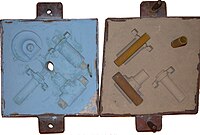
Photo from wikipedia
Chemically bonded sand cores and molds are an important part of metal casting technology and their interaction with metal (mold–metal interface) is of great interest. Currently, the metal casting industry… Click to show full abstract
Chemically bonded sand cores and molds are an important part of metal casting technology and their interaction with metal (mold–metal interface) is of great interest. Currently, the metal casting industry places a strong emphasis on near-net-shape and thin wall castings, while simultaneously maintaining increasingly stringent dimensional reproducibility requirements. To efficiently and cost effectively accomplish this task, it becomes crucial to ensure or “qualify” high-quality performance at the mold–metal interface. The thermal distortion test (TDT) was used in published American Foundry Society (AFS) studies as a laboratory technique to determine the presence of anomalies and for measuring distortions in chemically bonded sand binder systems. However, these laboratory tests focus purely on sand binder system behavior, without considering the effects of actual mold–metal interfaces. While the TDT provides valuable insight, it is unable to ensure castings will be free (or contain an acceptable amount) of specific defects. Therefore, to maximize casting quality and efficiency, it becomes imperative to incorporate casting trials into a foundry’s quality control system. This will allow the occurrence of potential casting defects to be observed at the mold–metal interface. This paper presents a casting trial technique that provides three specific benefits to foundry quality control systems. First, these trials will qualify sand binder systems against a specific casting surface defect(s), such as surface roughness, veins, penetration, cuts, washes, and erosion. Second, these casting trials are implemented under constant casting, mold, process, and design parameters. This allows the casting trial(s) to provide diagnostic information (i.e., if a specific defect occurs when using a qualified sand binder system, the cause cannot be related to the sand binder system). Third, the casting trial technique provides new opportunities for data analysis and deeper system understanding. Specifically, results in this paper identify the possibility of a potential relation between TDT data (e.g., anomalies and distortions) and actual casting trial data (e.g., defects).
Journal Title: International Journal of Metalcasting
Year Published: 2017
Link to full text (if available)
Share on Social Media: Sign Up to like & get
recommendations!